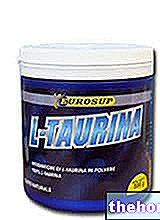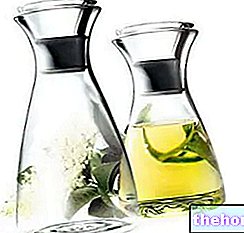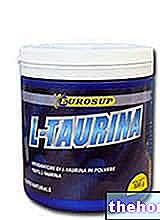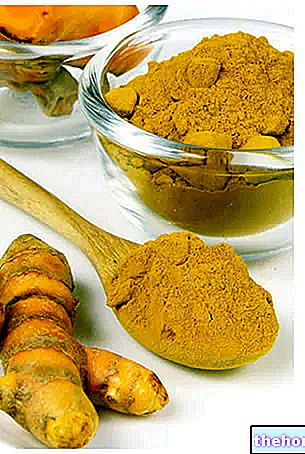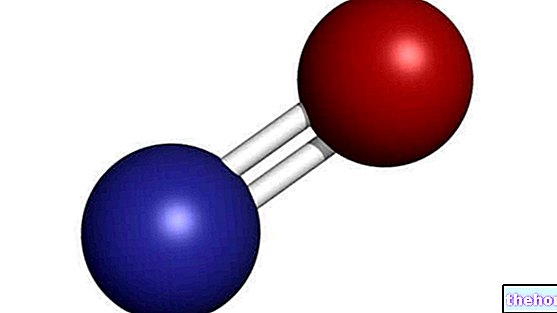Food supplements containing blue-green microalgae, mainly belonging to the species, are marketed under the generic term "Klamath algae" Aphanizomenon flos-aquae; the term Klamath is a clear reference to the origin of these algae, grown in the waters of the homonymous lake - Upper Klamath Lake - in Oregon (United States), then pulverized and dried before being placed on the market.
In case of need, food supplementation with Klamath Algae can be useful for providing significant quantities of minerals, antioxidants and vitamins, useful for filling specific deficiencies or satisfying an increased need.

Method of use and nutritional properties
The recommended intake of Klamath algae for supplementary purposes is in the order of 2-3 grams per day, reaching five grams in exceptional cases. The product is available in powder or capsule form; generally, it is recommended to take it in a single dose in the morning by swallowing it with water.
LARN /
RDA
Niacin (B3)
In the face of such a low intake, not to be exceeded at least for prudence, it is natural to ask how such a dosage can be effective in significantly integrating the nutritional intake of micro and macronutrients. With reference to the latter (proteins, carbohydrates and lipids), it is clear that the nutritional contribution of this supplementary strategy is modest and in any case lacking the miraculous tones with which it is promoted for commercial purposes. For example, if three grams of Klamath algae are taken per day, the content of essential amino acids, even if it is particularly high in relative terms (0.6-0.7 g of protein per gram of product), is too low in absolute terms, given that the The protein requirement of an adult of 70 kg of normal weight is approximately 70 grams per day. At similar doses of intake, even the 15-18 mg of alpha linolenic acid (progenitor of the omega three) present in each gram of Klamath Algae are all in all modest: data in hand, compared to a daily requirement of α-linolenic acid in the order of 500-1000 mg, three grams of Klamath Algae cover only 5-10% of this requirement.
LARN /
RDA
Therefore, if the consumer intends to resort to specific supplements of essential amino acids or omega three fatty acids, he should focus - respectively - on protein and amino acid supplements, and / or on the use of fish oils rich in EPA and DHA or vegetable rich in alpha linolenic acid (eg linseed oil, hemp oil, walnut oil, canola oil).
As regards the micronutrients (vitamins and minerals) and the so-called phytochemicals, the Klamath seaweed can be considered to all intents and purposes a valuable supplementary source, especially for the vegan population or for those who prefer the use of natural products to the synthetic counterpart. .
As shown in the table, three grams of Klamath seaweed cover a large part of the daily requirement for some vitamins and minerals. Even vitamin B12, whose bioavailability in plant sources has always been the subject of criticism, could be present in the Klamath alga in an at least partially bioavailable form [6], although other studies [11] deny this hypothesis. of chlorophyll, polyphenols (caffeic acid) and phycocyanin, which together with the abundance of carotenoids, contribute to raising the antioxidant power of the klamath seaweed. On these bases, the klamath seaweed is attributed a long series of benefits in prevention and treatment of various conditions, in which the excess of free radicals or possible nutritional deficiencies play an important role.
Efficacy Tests and Clinical Studies
In our opinion, the amount of studies published on pubmed is insufficient to justify miraculous attitudes towards this dietary supplement. By selecting only the randomized double-blind placebo-controlled clinical trials, there is preliminary evidence of a possible utility in the treatment of depression and in the improvement of psychophysical well-being in postmenopausal women not treated with HRT [7,8], in addition to a possible stimulating effect on the immune system [9,10]. Some of these studies refer to the whole seaweed, others to specific patented extracts of klamath seaweed, such as Klamin ® (see bibliography) in which the seaweed is artificially enriched with particular substances, such as phycocyanins or phenylethylamine, in order to obtain the desired benefits. In this regard, a consideration appears necessary: if the "klamath seaweed was really the prodigious miracle of nature accurately described for commercial purposes, why is it necessary to add substances in its extracts to achieve the achievement of specific health goals?" , if one day an olive oil with anti-inflammatory included (increasing the levels of oleocanthal naturally present in food by 20 times) were marketed, some might say that olive oil solves muscle aches and fever better than ibuprofen! Too bad that in the absence of such enrichment in oleocanthal, to obtain the same result it would be necessary to take a dose of half a liter of olive oil!
However, the klamath alga remains a "good natural tonic", characterized by a considerable concentration of essential nutrients or in any case important for the health of the whole organism; however, the low recommended intake doses should objectively dampen excessive enthusiasm about the benefits obtainable from its use (increasing the intake doses beyond the recommended values is never advisable, much less in this case, considering the potential risks described in the next chapter) .
Naturally, the properties of the klamath alga are also supported by the numerous studies on the individual nutrients it generously contains, which contribute to raising its health benefits in the context of a varied and balanced diet. For example, considering the generous contributions of folic acid and vitamin B12, the klamath seaweed can be beneficial for those with high levels of homocysteine in the blood, therefore exposed to a greater cardiovascular risk. This aspect also gives rise to the numerous health properties attributed to it for commercial purposes which, however, we repeat, for the most part have yet to be scientifically confirmed.
The Ministry of Health - as is well known, very prudent in recognizing physiological and / or health properties of various supplements - inserts klamath seaweed in the list of substances allowed in food supplements (further evidence to support its safety of use), indicating it - in reference to its physiological effects - as useful for the "Normal Tone of" mood "16. Instead, it is NOT recognized as being useful for" the "supporting and restorative action" (assigned for example to spirulina), or "antioxidants, natural defenses of "organism, purifying functions of the" organism "(attributed to chlorella), although its nutritional values are in many respects comparable (and in some cases better) than the other algae mentioned. This aspect suggests that - for klamath algae - scientific evidence supporting its physiological and health effects is still scarce and therefore deserving of further study.
Safety of use and Contraindications
Much has been said and written about the safety of use of klamath algae and the possible dangers to the health of the consumer. Before proceeding with the analysis of their nutritional characteristics and properties, it is therefore necessary to take stock of this aspect, avoiding excessive alarmism.
Klamath algae (intended as microalgae A. flos-aquae extracted from Lake Klamath) are NOT in themselves toxic or dangerous to human health. However, they are subject to possible contamination by microcystins: a "global" problem that affects most of the planet's aquifers [15]. Like aflatoxins in cereals and heavy metals in marine algae (laminaria, fucus etc.), fresh or brackish water algae (spirulina, chlorella, klamath ...) can also be contaminated with toxic substances. In particular, similar to aflatoxins, microcystin contamination can cause severe liver problems; for this reason the aquifers and the various supplements are subjected to continuous checks. In some of these studies [1,12,13,17], in samples of A. flos-aquae concentrations of microcystins exceeding the safety limits suggested by the WHO for drinking water have been detected. However - considering that: a) these limits are several hundred times lower than the dosages revealed to be toxic for the experimental animal, with regard to which some authors have raised doubts about possible conflicts of interest (underlining the need to establish wider safety intervals, at least 5 times higher, which would extinguish any controversy regarding the safety of use by making all the samples analyzed fall within the standard) [15] , b) there have been no cases of toxicity in humans deriving from the use of klamath seaweed supplements, neither in Italy nor in other countries; c) the klamath seaweed contains good concentrations of potential natural antidotes (essentially antioxidants) against microcystins - excessive alarmism should be avoided: adhering to the normally recommended intake doses (max 4 g / day) the consumer should not run significant risks to their health (although some authors have come to less reassuring conclusions, stating for example that: "At the highest levels of contamination found, a risk to consumers can be expected following chronic or sub-chronic exposure to a reasonable daily consumption of 4 g . "[12]). It is also necessary to specify that most of the samples analyzed showed contamination levels well below the prudential limits of potential danger; it is therefore unfair that companies that operate professionally to ensure superior quality and safety klamath seaweed extracts are penalized for the non-compliance of a few.. Although some authors [13] come to believe "the commercial sale of products based on Aph. Flos-aquae for human consumption, in pure or mixed formulations, very questionable", it is still a supplement that has been used for years in most part of the countries of the world with no cases of microcystin toxicity.
Ultimately, for those wishing to supplement their diet with klamath seaweed-based products, we would like to recommend: a) a preventive medical consultation (as you should always do before taking any supplement); b) compliance with the intake doses suggested by the manufacturer; c) the choice of quality and certified products d) to avoid taking it during pregnancy, breastfeeding and under the age of 12. Having respected these tips, depriving yourself of this supplement due to the danger of microcystins does NOT seem a rational choice; the same reason should in fact be deprived of most of the other supplements and even many foods. For those wishing to deepen the studies on the safety of use of klamath algae we recommend reading this article or the studies cited at the end of the article.
The fact that klamath algae can somehow stimulate the activity of the immune system [9,10], requires particular caution in the course of autoimmune diseases (eg multiple sclerosis, lupus, rheumatoid arthritis and others) or concomitant use of immunosuppressive drugs , which could make its use contraindicated. The high content of vitamin K could interfere with pharmacological therapies based on coumarin anticoagulants. Caution also in case of liver disease: consult your doctor.
BIBLIOGRAPHY
- Assessing potential health risks from microcystin toxins in blue-green algae dietary supplements "by Gilroy DJ, Kauffman KW, Hall RA, Huang X, Chu FS., Published in Environ Health Perspect. 2000 May; 108: 435-9.
- Klamath microalgae and cyanobacterial toxins. Stefano Scoglio. 2011
- USGS: Upper Klamath Lake nutrient study
- Effect of a Klamath algae product ("AFA-B12") on blood levels of vitamin B12 and homocysteine in vegan subjects: a pilot study. Baroni L, Scoglio S, Benedetti S, Bonetto C, Pagliarani S, Benedetti Y, Rocchi M, Canestrari F. Int J Vitam Nutr Res. 2009 Mar; 79: 117-23.
- [Effects of Klamath Algae extract on psychological disorders and depression in menopausal women: a pilot study]. Genazzani AD, Chierchia E, Lanzoni C, Santagni S, Veltri F, Ricchieri F, Rattighieri E, Nappi RE. Minerva Ginecol. 2010 Oct; 62: 381-8. Italian.
- Effect of a 2-month treatment with Klamin, a Klamath algae extract, on the general well-being, antioxidant profile and oxidative status of postmenopausal women. Scoglio S, Benedetti S, Canino C, Santagni S, Rattighieri E, Chierchia E, Canestrari F, Genazzani AD. Gynecol Endocrinol. 2009 Apr; 25: 235-40.
- Natural killer cell activation and modulation of chemokine receptor profile in vitro by an extract from the cyanophyta Aphanizomenon flos-aquae. Hart AN, Zaske LA, Patterson KM, Drapeau C, Jensen GS.
- Mobilization of human CD34 + CD133 + and CD34 + CD133 (-) stem cells in vivo by consumption of an extract from Aphanizomenonflos-aquae - related to modulation of CXCR4 expression by an L-selectin ligand? Jensen GS, Hart AN, Zaske LA, Drapeau C, Gupta N, Schaeffer DJ, Cruickshank JA.
- Miyamoto E, Tanioka Y, Nakao T, Barla F, Inui H, Fujita T, Watanabe F, Nakano Y. Purification and characterization of a corrinoid-compound in an edible cyanobacterium Aphanizomenon flosaquae as a nutritional supplementary food. J Agric Food Chem. 2006 Dec 13; 54: 9604-7.
- Vichi S, Lavorini P, Funari E, Scardala S, Testai E. Contamination by Microcystis and microcystins of blue-green algae food supplements (BGAS) on the italian market and possible risk for the exposed population. Food Chem Toxicol. 2012 Dec; 50: 4493-9. Istituto Superiore di Sanità, Environment and Primary Prevention Department, Rome, Italy.
- Heussner AH, Mazija L, Fastner J, Dietrich DR. Toxin content and cytotoxicity of algal dietary supplements. Toxicol Appl Pharmacol. 2012 Dec 1; 265: 263-71.
- Gallo P. et al., Contamination by biotoxins in fish products and food supplements, in Food Ingredients, XI October, pp. 6-11, p.10.
- Scoglio S., The business of microcystins
- Ministry of Health - List of plant substances and preparations allowed in food supplements (updated to July 2012)
- "AFA-Algen - Giftcocktail oder Gesundheitsbrunnen?" Universität Konstanz. 1, 2008. Retrieved May 18, 2012.
Select plant Fir Acacia Acerola Sorrel Yarrow Yarrow Yarrow Aconito Adatoda Garlic Agnocasto Agrimonia Alchemilla Alkekengi Aloe Altea Witch Hazel Ammi or Visnaga Pineapple Andrographis Anemone Pulsatilla Angelica Anise Star Anise Japanese Star Anise Bitter Orange Bitter Areca Arnica Harpagophytum Arpagophyte Artemisia Asteragus Basil Asparagus Asparagus Peruvian Asparagus Asparagus Asparagus Hawthorn Boldo Borage Shepherd's Purse Boswellia Bucco Butea superba Cocoa Coffee Cajeput Calamus Calamus Marigold Camedrio Chamomile Roman Chamomile Camphor Cinnamon Ceylon Maidenhair Capuchin Artichoke Cardamom Cardiac Thistle Asian Thistle Carvi Cascara Cassia Catecu Catha Cabbage Celandine Chicory Centaurea Cinnamon Cypress Celandine Chives Cypress Coca Cola Colchico Combreto Condurango Comfrey Coriander Cranberry Barberry American Chrysanthemum Cumin Turmeric Damiana Digital Dioscorea Drosera Dulcamara Dunalilella Echinacea Eder a Ephedra Elenio Eleutherococcus Helichrysum Evening primrose Horsetail Alfalfa Erica Euphrasia Erisimo Escolzia Eucalyptus Farfara Farfaraccio Calabar bean Fenugreek Fennel Phytolacca Frangola Ash Fumaria Japanese Mushrooms Galega Ganoderma lucidum Garcinia Cambogia Mulberry Gentian Broom Ginkgo Ginkgo Guipana Guipana Gynestra Ginkgo Hibelia Gymnasium Hibiscus Guarulp St. John's Wort Horse Chestnut Ispaghul Hyssop Jaborandi Kava kava Konjac Laminaria Cherry Laurel Lavender Lemongrass Lespedeza Lovage Icelandic Lichen Lemon Flax Lippia Licorice Lobelia Hops Maca Marjoram Maize Mallow Manna Marrubio Marrubio d "water Matè Melaleuca Meliloto American Lemon balm Myrtle Myrama Walnut Nutmeg Walnut vomica Olive tree Meadowsweet Ononide Opuntia Oregano Orthosiphon Nettle Poppy Papaya Parietaria Feverfew Passiflora Chilli Perilla Periwinkle Phyllanthus Plantain Picrorhiza Pilosella Pino Pisci dia Podofillo Polygala Grapefruit Parsley Psyllium Pueraria mirifica Butcher's broom Pygeum Quassia Oak Rhubarb Ratania Rauwolfia currant Castor bean Rhodiola Rosehip Rosemary Rue Willow Sarsaparilla Sage Elderberry Sassafras Sedum Ergot Senna Serenoa Repens Soybean Solidago Tansy Taraxus Tamarind Tamarind Tamarind Tamarind Tamarindo Ursina Valerian Vanilla Mullein Verbena Veronica Viburnum Vinca Pansy Mistletoe Vine Withania Yohimbe Saffron Ginger Pumpkin Select disease Juvenile Acne Rosacea Tinnitus Tinnitus Aerophagia Tendon Affections Afonia Aphthae Algias Functional Halitosis Breastfeeding Allergy Anemia Anguish Anxiety Arteriosclerosis Asthrosis Asthrosis Arthritis Arthritis Men Sex Woman Blepharitis and Conjunctivitis Eye bags Bronchitis Gallstones Kidney stones Salivary stones Baldness Androgenetic Candida Fragile hair Caries Headache Cellulitis Motion sickness Cystitis C limaterio Cholecystopathy High cholesterol Ulcerative colitis Colonoscopy Contusions Hematoma Convalescence Couperose Depression Dermatitis Diaper dermatitis Diabetes Diarrhea Erectile dysfunction Dyslipidemia Dysmenorrhea Dyspepsia Disturbances of vision Hemorrhoids Epistaxis Herethism Heart disease Fever Fibromyalgia Gastro-intestinal disease Flatulence Hypertension Fibromyalgia Gastrointomnia Jaundice Laryngitis Renal lithiasis Toothache Sore throat Thinness Menopause Meteorism Mononucleosis Alzheimer's disease Crohn's disease Nausea Vomiting Obesity Dark circles Onychomycosis Osteoporosis Dry skin Periarthritis Piorea Low pressure Prostatitis Psoriasis Colds Breast fissures Anal fissures Gastro-nasal rhinitis Senescence Premenstrual Syndrome Sinusitis Quit smoking Overweight Fatty liver Constipation Stomatitis Stress Cough Triglycerides high Ulcer Burns Nails Brittle flashes Heat Warts Dizziness Properties herbal Tanning Abortive adaptogenic Aphrodisiac bittering analgesic anesthetic anorectics analgesic antacid anti-allergic anti-asthmatic Antibiotic catarrh Anticellulitiche anticonvulsant Antidiaforetiche antidiarrheal edematous anthelmintic antiemetic Antiemorroidarie antiphlogistic Antiidrotiche Antinevrotiche Antioxidants antipyretic antirheumatic antiscorbutic Antiseptic antispasmodic anti-uric Aperitive Flavoring Astringent Balsamic Bechiche Capillarotrope Cardiotonic Carminative Cathartic Caustics Healing Cholagogues Choleretic Dyes Decongestants Deodorants Purifying Diaphoretic Cleansers Disinfectants Detoxifiers Thirst quenching Diuretics Exciting Emetics Emmenagogues Emollients Hemostatic Energies Hepatoprotectors Expectorants Eupepticus Moisturisers Galactosensitizers lanti Hypertensive Hypnotic Hypoglycemic Hypotensive Irritants Laxatives Soothing Narcotic Nerves Nutrients Odontalgic Pectoral Purgative Revulsive Remineralizing Refreshing Rubefacient Scialagoghe Sedative Soporifugas Sneezing Stomachic Stomatics Narcotic Vascular Tightenitis

